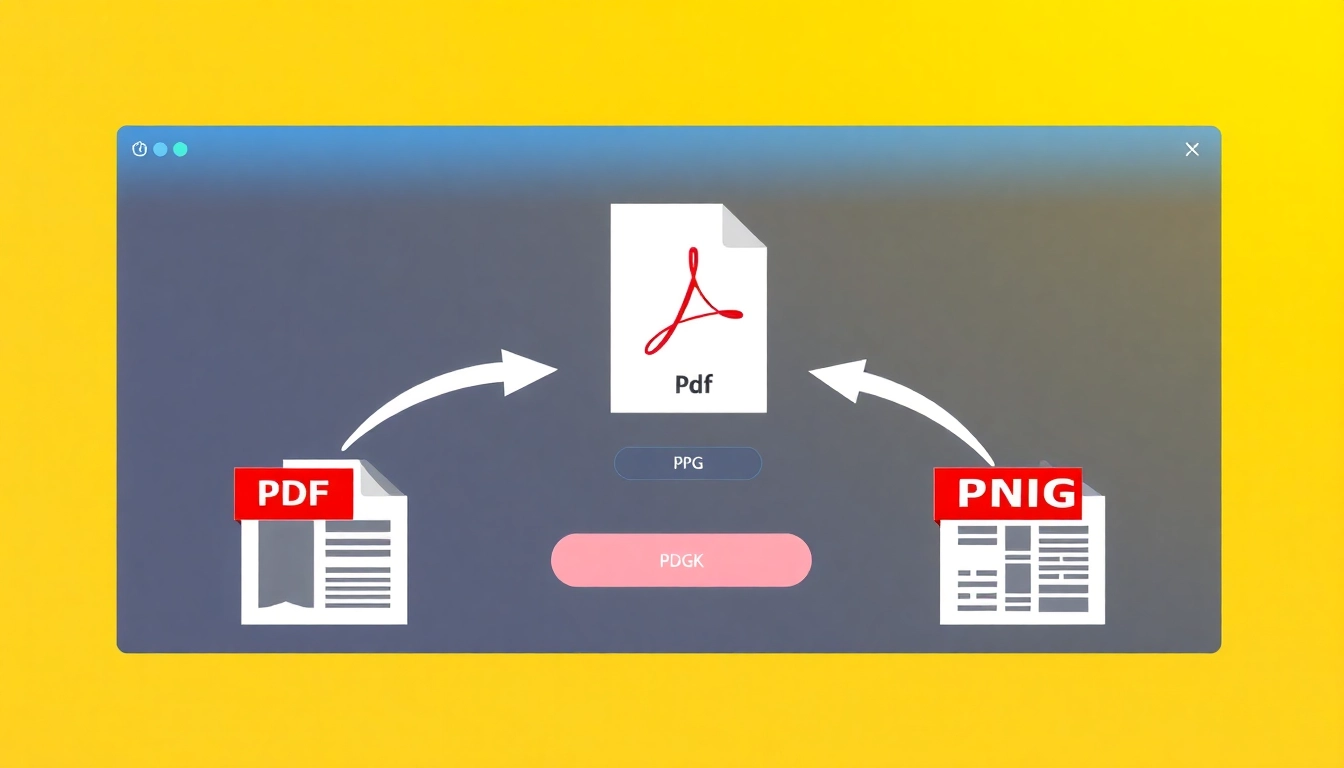Understanding PDF to JPG and PNG Conversions
What is PDF and Why Convert It?
Portable Document Format (PDF) has become one of the most widely used file formats for distributing electronic documents. Designed by Adobe in the early 1990s, PDF allows for the presentation of documents in a manner independent of application software, hardware, and operating systems. The advantages of using PDFs include their ability to retain complex formatting, embed fonts, and include vector graphics. However, there are times when converting PDF files to more accessible image formats, such as JPG and PNG, becomes necessary.
Converting PDF to JPG or PNG is essential for sharing information on social media, embedding images in presentations, or simply for easier viewing and printing. For instance, if you have a PDF file containing an infographic, converting it to an image file makes it easier to disseminate across various platforms, such as websites, emails, or print materials. Additionally, images in JPG and PNG formats tend to occupy less space and load faster, enhancing user experience on digital platforms.
Ultimately, such conversions cater to user needs and improve the utility of digital documents. For comprehensive options, explore various tools online that provide pdf to jpg and png capabilities.
Benefits of JPG and PNG Formats
Understanding the advantages of the JPG and PNG formats is crucial for choosing the right format for your needs. Both formats serve different purposes and present unique benefits:
- JPG (Joint Photographic Experts Group): JPG is primarily used for photographic images. It supports a wider range of colors, making it ideal for images with gradients. One of its key advantages is its compression capabilities, allowing users to reduce file size significantly with a slight loss of quality, which is often unnoticeable to the naked eye. This makes JPGs perfect for web usage where loading speed is a priority.
- PNG (Portable Network Graphics): PNG is best known for its lossless compression, meaning the quality does not degrade even when the file size is reduced. This format handles transparency better, allowing for clearer images when layered over other visual elements. PNG is particularly recommended for graphic design work, images containing text, or when editing images is necessary since it preserves more details than JPG.
Each format has its strengths. Understanding these can help individuals and businesses make informed decisions when sharing or posting images online.
Common Use Cases for PDF Conversions
PDF to image conversions facilitate several practical scenarios, including:
- Graphic Design: Designers frequently convert PDFs to PNGs or JPGs for advertising material, mockups, and presentations. The quality and clarity of images are essential when showcasing designs.
- Email Attachments: Converted images are easier to send as attachments in emails, especially when dealing with recipients who may not have compatible software to view PDFs.
- Web Content: Blogs and websites often require images to supplement their articles. PDFs containing informative graphics or charts can be converted into images to enhance online content.
- Social Media: Platforms like Instagram and Facebook thrive on visuals. Converting PDFs holding captivating designs, illustrations, or infographics allows easier sharing across social platforms.
Understanding these use cases highlights the importance of mastering PDF conversions.
How to Convert PDF to JPG and PNG Online
Step-by-Step Conversion Guide
Converting PDF to JPG or PNG is straightforward, especially with online tools. Here’s a simple step-by-step guide on how to execute this conversion:
- Select a Conversion Tool: Choose a reliable online converter. Popular alternatives include Adobe Acrobat online, Smallpdf, or Sejda.
- Upload Your PDF: Drag and drop the PDF file into the selected conversion tool or use the upload button to locate your file.
- Select Output Format: Once the PDF is uploaded, choose whether you want the output as JPG, PNG, or another compatible image format.
- Adjust Settings (Optional): Many tools allow you to adjust settings, such as image quality, dimensions, and page selection for conversion.
- Convert and Download: Click the convert button and wait for the process to complete. Once finished, download the converted image files.
Following these steps enables users to quickly and efficiently convert their PDFs into usable image formats.
Using Free Online Tools
Numerous free online tools are available for seamlessly converting PDF files to image formats. Some notable options include:
- Smallpdf: This user-friendly platform allows simple drag-and-drop functionality, enabling users to convert files efficiently while offering the choice of entire pages or individual images.
- iLovePDF: With a straightforward interface, iLovePDF helps users convert each page of a PDF into JPG format, ensuring the process is quick and user-centric.
- pdf2jpg.pro: Known for its simplicity and speed, this tool allows users to convert PDF files into high-quality JPG images with minimal fuss.
- Canva: Besides traditional design capabilities, Canva offers PDF to JPG conversion, allowing users to edit their images in a visually appealing format.
These platforms offer versatile options for users looking to handle specific conversion needs without spending money.
Ensuring Quality During Conversion
To maintain image quality during the PDF to image conversion process, consider the following tips:
- Choose the Right Tool: Not all converters produce the same quality. Always opt for trusted tools with good user reviews.
- Adjust Settings: If the tool provides options, select higher resolution settings to avoid pixelated images after conversion.
- Check for Page Selection: If the PDF contains multiple pages, be sure to specify which pages you want to convert, as some tools can convert the entire document or select only specific sections.
Taking these steps can optimize output quality and ensure that images meet your usage needs.
Comparing Different Conversion Tools
Top Tools for PDF to JPG and PNG
With countless options available in the market, identifying the most effective PDF to JPG and PNG conversion tools can be perplexing. Here are some of the top contenders:
- Adobe Acrobat: Renowned for its reliability and comprehensive PDF capabilities, Adobe’s online tool allows users to convert PDFs seamlessly to JPG or PNG.
- Smallpdf: With its variety of PDF-related functionalities, smallpdf.com offers a simple and fast method of converting PDFs to image formats while maintaining integrity.
- Sejda: Known for its user-friendly experience, Sejda allows personalization in conversions with features like choosing image resolution and page selection.
- iLovePDF: This versatile tool stands out with its ability to convert all types of files while ensuring high-quality image outputs.
Familiarizing yourself with these tools will aid in selecting the most suitable option based on specific needs.
User Reviews and Ratings
Understanding user experiences can provide valuable insights into the effectiveness of various conversion tools. For example:
- Adobe Acrobat: Rated 4.6 stars across many platforms, users appreciate Adobe’s reliability and the quality of its conversions.
- Smallpdf: With over 320,000 ratings, Smallpdf holds a commendable 4.6-star rating, praised for its efficiency and user interface.
- iLovePDF: Commonly recommended for its simplicity, users favor it for converting single pages and complete documents effectively.
Reviews highlight features that resonate, allowing users to make informed decisions when selecting tools for their conversion needs.
Cost vs. Free Options: What to Choose?
While many online conversion tools are available for free, some offer premium options with additional features. Evaluating whether to use a free service or invest in a premium solution involves considering:
- Frequency of Use: If conversions are a daily task, investing in a premium tool may be worthwhile to ensure reliability and quality.
- Desired Features: Premium tools often provide additional functionalities like batch processing, enhanced image quality, and superior customer support.
- Experimentation: Free trials of premium tools can provide insights into their effectiveness, allowing users to gauge whether the investment is justified.
By weighing these factors, users can discern their exact needs and choose wisely.
Troubleshooting Common Conversion Issues
Quality Loss During Conversion
A common concern during any conversion is the potential loss in quality. Here are some strategies to address quality loss:
- Select High-Quality Sources: Use high-resolution PDFs to start with, ensuring the best possible output.
- Use Trusted Conversion Tools: Opt for reputable tools, as some may provide advanced algorithms that minimize quality degradation.
- Check Settings: Always review image quality settings before initiating a conversion to avoid pitfalls.
By evaluating these factors, users can achieve significant quality retention during conversions.
File Size Considerations
File size can impact usability, especially when sharing images online. To optimize file sizes without compromising quality:
- Choose Compression Options: Some tools allow for compression levels; utilize these wisely for minor files without significant quality loss.
- Review Resolution Settings: High-resolution images will take more space; users might reduce resolution for web sharing without complications.
Balancing size and quality effectively yields functional image files readily integrated into various platforms.
Failed Conversions: Causes and Solutions
Often, users may face issues where conversions fail to complete successfully. Common causes include:
- Weak Internet Connection: Ensure that the connection is stable, as poor internet can interrupt or corrupt the conversion process.
- Unsupported File Types: Verify the PDF type; some conversion tools may not support certain file formats.
- File Size Limitations: Ensure the file does not exceed the tool’s size limits; consider reducing the size of large PDFs before uploading.
Approaching troubleshooting systematically ensures minimal disruptions in the conversion process.
Future of PDF to JPG and PNG Conversions
Emerging Technologies in Document Conversion
The future of PDF to image conversions is bright, with technology continually evolving, evident in advanced features being integrated into conversion tools. Innovations such as:
- AI-Powered Converters: AI-driven tools can better learn user preferences, automate the selection process, and enhance overall conversion accuracy.
- Real-Time Collaboration: Future applications may include real-time collaboration features where users can edit and convert documents without switching tools.
- Mobile Integration: With the growing reliance on mobile technology, expect more online converters to offer superior mobile optimization for on-the-go conversions.
Such advancements will improve user experience and efficiency, positioning online converters favorably within changing digital landscapes.
Trends in Digital File Management
As professionals and organizations transition to a digital-first approach, digital file management trends will dictate the methods for handling file conversions, including:
- Cloud Storage Integration: As collaboration through cloud platforms increases, expect stronger integrations with popular cloud storage solutions, enabling seamless exporting and importing of files.
- Security Features: As privacy concerns rise, tools emphasizing document security will become prominent, offering encryption and secure file transfer options.
Embracing these trends will enhance productivity as users adapt to the evolving nature of digital file management.
Best Practices for Users Moving Forward
For users looking to enhance their experience with PDF to JPG and PNG conversions, embracing best practices can foster better outcomes:
- Stay Informed: Regularly research and read user reviews to stay updated on the latest tools and technologies.
- Test Different Tools: Experimenting with various tools may reveal which works best for specific needs and preferences.
- Keep Files Organized: Maintain clear organization by labeling files and categorizing them for easy retrieval during the conversion process.
By implementing these practices, users can navigate the conversion landscape proficiently.









